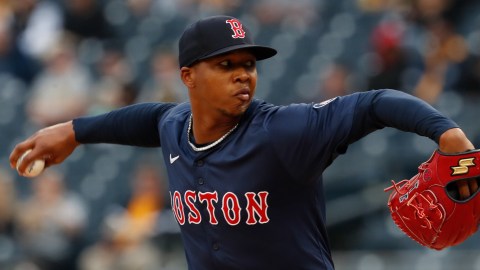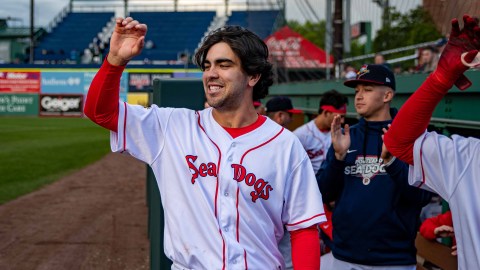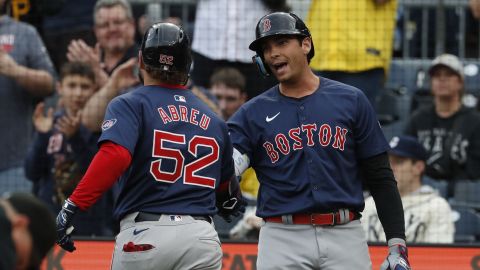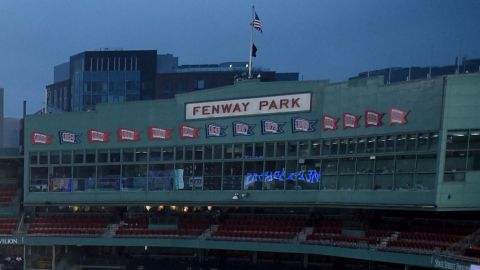 There are few slam dunks when projecting the major league careers of prospects.
There are few slam dunks when projecting the major league careers of prospects.
Although MLB teams horde prospects because of the necessity of having cost-controlled players producing while they’re in their prime years, really it’s a numbers game. Teams understand that projecting prospects is, essentially, a war of attrition, and even players labeled as “can’t miss” do just that far more often than not. Even someone like Justin Upton, who by most accounts has been a disappointment for the Diamondbacks, is considered a success insofar as he’s a viable, relatively productive major league regular.
But it’s exactly this kind of thinking that means it’s rarely advisable for a team to give up a known quantity for prospects unless there are overriding financial considerations, or a team is waving a white flag on the season. By the same token, it’s that same train of thought that likely gives many fans pause when they hear the rumors linking Jon Lester to the Kansas City Royals and the Red Sox to top prospect Wil Myers.
In short, the Royals want pitching, they like their offense at the major league level (and with a lineup featuring Alex Gordon, Billy Butler, Eric Hosmer and Mike Moustakas, why wouldn’t they?) and they’re willing to give up minor league talent to acquire major league pitching, having already wrested Ervin Santana from the Angels this offseason. The team apparently really likes Lester — despite his debacle of a 2012 campaign — and their only real minor league piece of value is 2012 Baseball America minor league player of the year Myers.
It’s not difficult to see how these rumors got started.
Now, the Red Sox have already denied that Lester is a part of any potential trades, but that doesn’t necessarily mean anything. It does indicate that a straight-up Myers-for-Lester trade isn’t likely, but it’s still within the realm of possibility (however unlikely) that the two could be a part of a deal with other pieces involved. And the reasoning for that is what has already been mentioned: the Red Sox are seemingly hesitant to trade a known quantity for a prospect.
However, all that being said, if the Red Sox do or did have the opportunity to acquire Myers for Lester, even straight up, that’s a risk the team should absolutely take.
Potentially trading Lester for Myers not only brings a potential star into the fold in Boston — the kind of player you could hope to build a team around — but it opens up all sorts of intriguing possibilities as the team continues to rebuild. More to the point, trading Lester and bringing aboard Myers would absolutely not preclude from the Red Sox contending in 2013.
Currently the Red Sox have holes at the corner outfield spots, first base, shortstop and one rotation slot available (assuming the likely return of John Lackey). This proposed trade would obviously take care of one of the corner outfield slots and open up a new spot in the rotation, but it would also take about another $11 million off of the payroll in what’s owed to Lester in 2013.
In short, there are other pitching options out there — everyone from Dan Haren to Shaun Marcum to Edwin Jackson — who may well be able to approximate Lester’s projected contribution. But, of course, Lester wasn’t very good in 2012, so it begs the question what the Red Sox see in him that suggests a comeback. Despite his age, Lester seemed to struggle with every aspect of his game — including velocity, location and mechanics — last year, so betting on a return to form from him seems as big a gamble as betting on Myers.
And, returning to Myers, he’s the kind of player who could lead a team offensively for the next decade-plus. Imagine Will Middlebrooks and Myers in the middle of the Red Sox’ order through the 2010s — it’s a scary thought.
Putting your faith in any prospect is a gamble, but Myers showed much in terms of his ability to make adjustments in 2012. The first was his preseason adjustment to take more aggressive swings and use his power — which yielded the first 100-strikeout season of his career, but also led to 37 home runs and a .600 slugging percentage across Double- and Triple-A.
The second adjustment Myers made was his successful transition from the hitter’s-haven Texas League to Omaha of the Pacific Coast League. At Triple-A, Myers was one of the very youngest players in the league, yet cut his strikeout rate back to his career norm as he saw less pitches to hit — yet still slugged .554 in 99 games. There’s no crystal ball that allows the powers that be to see into the future and determine how a prospect will pan out, but pitch recognition is about as good an indication as we have — and Myers’ pitch recognition is through the roof.
Wil Myers, like any prospect, is a gamble. But it’s a gamble the Red Sox should not hesitate to take on if given the opportunity
Photo via Facebook/Wil Myers



